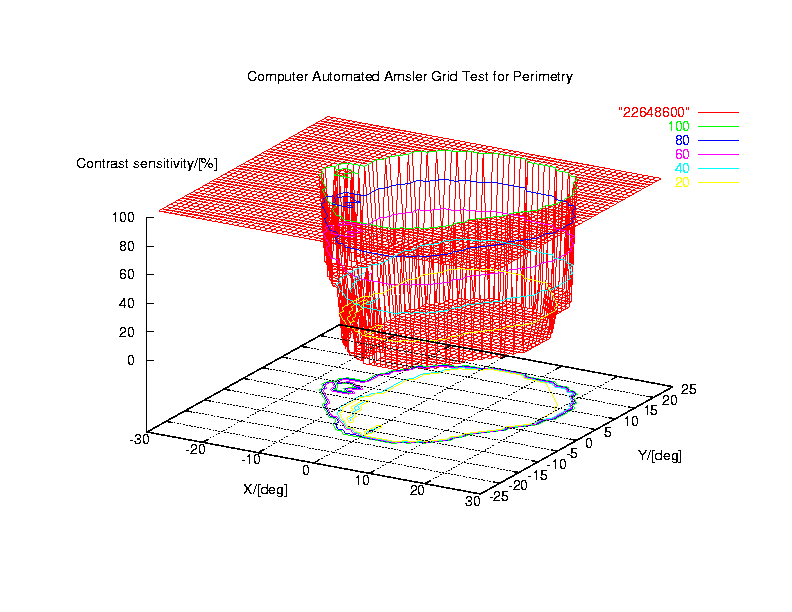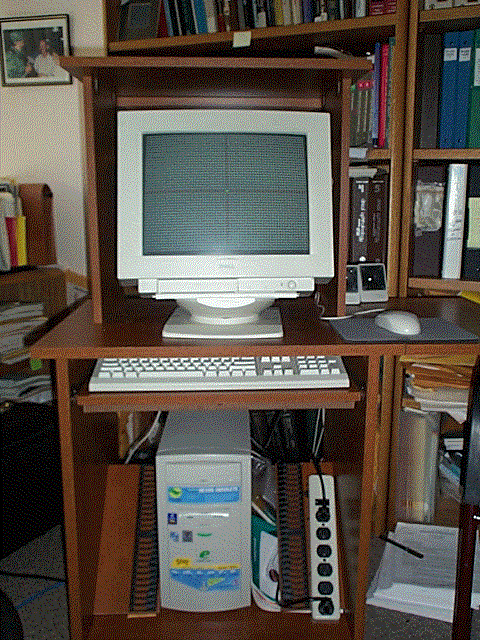3-D Computer-Automated Threshold Amsler Grid Test


To the
Test Site...
Caltech Press Release
USC News USC Today
USC HSC WEEKLY
USC Trojan Family Magazine
USC USC Health Magazine
NSF Press Release
NSF News Highlights
JPL
Media Release
JPL
website
KCET Life & Times Tonight
Spiegel Online
Informationweek
SpaceDaily
SPACE.com
Spinoff Technologies
Aerotech News and Review
Federal Telemedicine News
GeoCities
MacNow Magazine
Science News Network
PITSCO The Cause
Mechanical Engineering
Abstract
Depiction of Examination Results
Method & Examination Procedure
Slide Show of Examination Device
Discussion
Upcoming Talks
Scientific Contact
Licensing Contact
Caltech/USC Technology Disclosure
Sign-up for Mailing List
Related Research Projects in Perimetry
Related Research Projects
For more information:
Explanatory VHS video tape (35 min) about the 3-D Computer-Automated Threshold Amsler Grid Test
A production fee of US $25 including mailing will be charged (credit card via PayPal or check only)!

To place an order, please, send us an e-mail:

Abstract
Purpose: Development and implementation of a computer-automated system for near threshold central visual field acquisition in establishing 3-D displays of (central) visual fields (hill-of-vision). The patient will indicate the visible perimeter of vision in a variety of contrast presentations. This will not only reveal relative as well as absolute scotomas but permit the calculation of the slope of the depression.
Methods: We have developed a computerized test program that displays an Amsler grid at a preselected greyscale level and preselected angular resolution on a computer screen at a fixed distance. The patient, with the Troxler effect suppressed centrally, is able to mark the areas on the Amsler grid that are missing from his field of vision. The same procedure is then repeated at various greyscale levels - simulating increasing degrees of contrast - and the respective results are recorded and later automatically displayed by the computerized test program. A total of approximately 4-5 minutes per eye is required. With these results, a 3-D depiction of the (central) visual field is obtained, describing the location, extent, slope, depth, and shape of the scotomas.
Conclusions: This new, completely computer-based test, offers a novel method for evaluating the central visual field with the additional parameter of depth. This test provides several advantages over conventional perimetry including: 1) additional information through 3-D rather than 2-D depiction of scotomas, 2) superior angular resolution, and 3) direct patient interaction with a computerized system in a much shorter examination time.
Depiction of Examination Results
Optic Neuritis:


Anterior Ischemic Optic Neuropathy (AION):


Glaucoma:


"Dry" Macular Degeneration:


Method & Examination Procedure
The examination with our computerized test program should take place in a separate examination room with well-defined ambient brightness.
After dark adaptation the patient will be positioned in front of the computer monitor at a fixed distance - determining the angle of the visual field - by means of both a chin- and head-rest.
The eye not under examination will be totally covered with an eye-cover. If need be, a necessary refractive correction has to be applied by means of the patient's eye-glasses or contact lenses, or correction glasses.
Our computerized test program then displays an Amsler grid at a preselected greyscale level and preselected angular resolution on the computer screen.
The patient, with the Troxler effect suppressed centrally, is able to mark the areas on the Amsler grid that are missing from his field of vision. He does that by either circumscribing/outlining the missing areas (scotomas) directly on the touchscreen, by using a lightpen or similar pointing device. If necessary, a mouse or even the keyboard would work in lieu of a touchscreen.
The same procedure is then repeated at various greyscale levels - simulating increasing degrees of contrast (contrast sensitivity levels) - and the respective results are recorded and later automatically displayed by the computerized test program.
A total of approximately 4-5 minutes per eye is required.
With these results, a 3-D depiction (hill-of-vision) of the (central) visual field is obtained, describing the location, extent, slope, depth, and shape of the scotomas.
Slide Show of Examination Device

Discussion
Conventional perimetry and even campimetry provides information pertaining to the borderline between seeing and non seeing areas. At most, in some forms of automated perimetry, a mean sensitivity to light within a scotoma is displayed. The present techniques, however, do not provide the extra information inherent in a region of visual depression that is available by our system: Our system displays the area of depression in X and Y axis (relative to visual fixation) but also, on the Z axis in regard to visual contrast sensitivity.
Not only does 3-D information permit further distinctions between certain visual disorders (ARMD might cause an absolute scotoma while macular edema only produces a relative scotoma) but the 3-D shape of each visual depression has the potential for the development of a library of shapes and slopes that are likely to be signature patterns for various ophthalmological conditions.
Our new, completely computer-based test, offers a novel method for evaluating the central visual field. This test provides several advantages over conventional perimetry including:
- additional information through 3-D (includes depth) rather than 2-D depiction of scotomas
- superior angular resolution
- direct patient interaction with a computerized system in a much shorter examination time
- use of regular computer equipment (no additional equipment necessary)
- distributability over the Internet
- interactive accessability over the Internet
- portability via laptop
- software package can easily be updated/modified.
Scientific Contact
Wolfgang Fink, PhD
Jet Propulsion Laboratory (JPL)
Pasadena, California 91109, USA
Phone: (818) 393-2695
Fax: (818) 393-4540
also:
W. K. Kellogg Radiation Laboratory
California Institute of Technology
Pasadena, California 91125, USA
Phone: (626) 395-4587
Fax: (626) 564-8708
E-mail: wf@wfbabcom5.com
Homepage: http://www.wfbabcom5.com
Alfredo A. Sadun, MD PhD
Doheny Eye Institute and Keck School of Medicine at USC
Los Angeles, California 90033, USA
Phone: (323) 442-6417
Fax: (323) 442-6407
E-mail: ASADUN@HSC.USC.EDU
Licensing Contact
Office of Technology Transfer at Caltech
Sign-up for Mailing List
To join our mailing list, please, submit your e-mail address here:
 This page will be frequently updated!
This page will be frequently updated!

Copyright © by Dr. Wolfgang Fink
e-mail: wf@wfbabcom5.com
Homepage
Last modified: Fri 31 Oct 2003 at 12:00 AM














